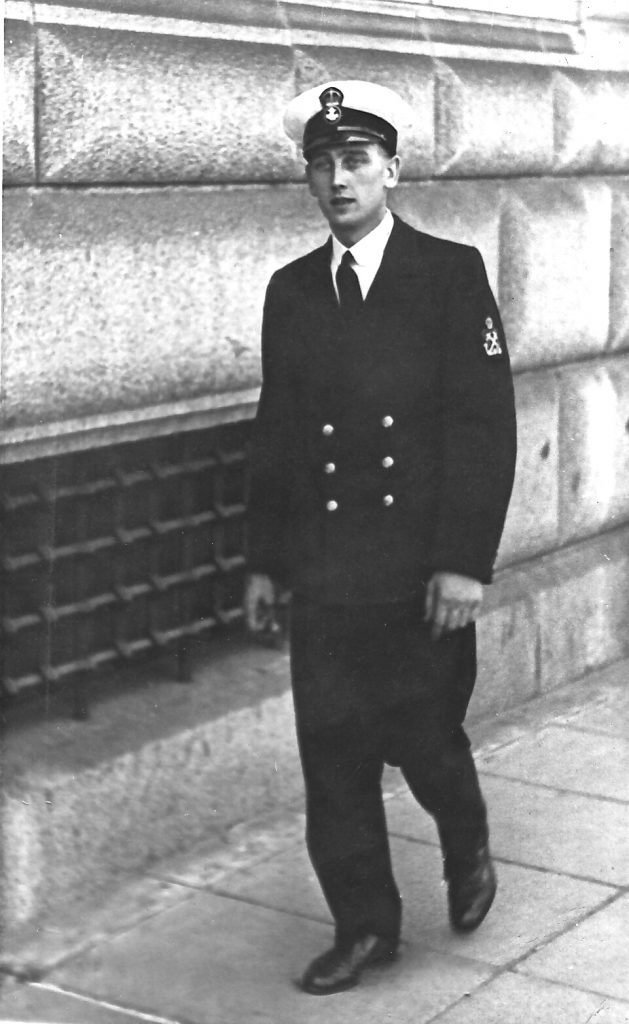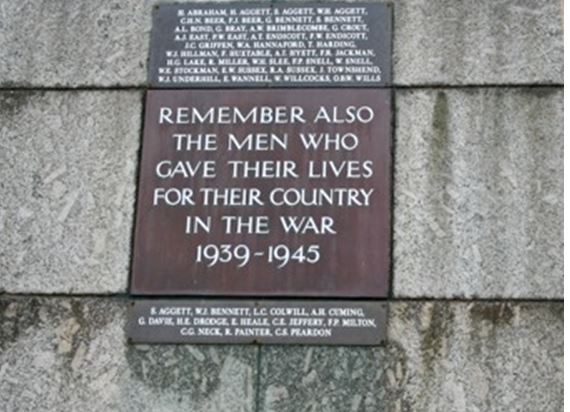Reprinted from Lustleigh Parish Magazine December 2016
As you are wrapping your Christmas presents later this month, I would ask you to spare a thought for a man who lost his life 75 years ago in one of the most extensive but least known naval disasters of the Second World War. His connections with Lustleigh may only be slight, indeed he is not listed on our war memorial, but the tragedy on 19th December 1941 in which he fell deserves being brought before a wider audience.
Ronald Painter was born on 13th March 1914 to William Scott Painter and Mary Ann Painter of Court Street, Moretonhampstead and baptised in that town on 18th April 1915. Eagle-eyed readers will, no doubt, immediately spot a connection between our village and Ronald’s father’s name, but more of that later.

Front row – William Scott, Ronald (aged 3) Mary Ann
Back Row – Harold, Kathleen, Frank
The Painters were a large Chagford family of stone and monumental masons. William had moved to Leigh House, Brookfield by 1901 with his mother and two of his brothers. It is thought that they may have run East Wrey quarry, and hence the move; the 1901 census entry showing William as an employer and a 1902 trade directory listing the Painters of Lustleigh as granite quarry proprietors would certainly fit with this theory.
Following William’s marriage to Mary Ann Casely in Wandsworth (her father was a prison warder there) in 1901, they had two sons born in Lustleigh before relocating to Moretonhampstead around 1905 where they had a daughter and, much later, their third son, Ronald.
Ronald attended Pound Street School in Moretonhampstead between 1922 and 1928, after which he embarked on an apprenticeship at a motor garage in Newton Abbot. Shortly after his father died in 1935, Ronald decided to follow his older brother, Harold, into the Royal Navy; unsurprisingly, with his mechanical background, becoming an Engine Room Artificer.

Ronald’s precise history with his ship, HMS Neptune is unknown. The Leander Class Cruiser certainly spent the initial months of WW2 patrolling the south Atlantic where, in November 1939, she was part of Force “K” looking for Admiral Graf Spee. The following year, she was transferred to operations in the Mediterranean and following a refit in 1941 hunted for German supply ships supporting Bismark.
Towards the end of 1941, Ronald and HMS Neptune were back in the Mediterranean and back with “K” Force which this time was tasked with seeking and destroying German and Italian convoys carrying troops and supplies to Libya in support of Rommel’s army in North Africa. It was to be a fateful mission.

On the afternoon of December 18th the squadron was despatched from Malta to intercept an important enemy convoy bound for Tripoli. Neptune was leading two other cruisers, Aurora and Penelope, with the support of four destroyers, when at 0106 am, she struck a mine. The cruiser force had run into a minefield in a depth of water and at a distance from land which made it utterly unexpected.
Attempting to exit the minefield, she backed her engines, but 10 minutes later hit another mine, losing propellers and rudder and going dead in the water. Now at the mercy of wind and heavy seas, she struck a third mine. One of the destroyers, Kandahar, attempted to take Neptune in tow, but caught a mine herself, at which point Captain O’Conor of the Neptune flashed a warning, “Keep away”. At 0403 she struck a fourth mine which exploded amidships: this was more than her hull could take and she turned over and sank within minutes.
Thirty crew managed to reach Carley rafts; with all ships ordered to leave the area due to the extreme danger, these survivors had to fend for themselves. Newspapers as late as January were reporting that enemy statements said some of the survivors had been picked up and taken prisoner. In reality, left exposed to the elements and without food or water, all but one of the initial survivors perished. After five days adrift, Leading Seaman Norman Walton was found by an Italian torpedo boat, Calliope, on 24 December.
As well as being one of the worst losses of life at sea in World War II, with 763 crew of Neptune being despatched along with 73 men from HMS Kandahar, it was the worst naval tragedy for New Zealand who had contributed greatly to the crew. As well as being remembered on many national memorials (Ronald on Plymouth Naval Memorial), all 837 men are commemorated on a special Neptune and Kandahar Memorial. Unveiled in 2005 at the National Memorial Arboretum in Staffordshire, its pyramid base is orientated towards the point north of Tripoli where HMS Neptune went down. Ronald is additionally listed on Moretonhampstead’s war memorial.
Although a Board of Inquiry was held within a week of the disaster, the British worked hard to conceal the scale of the calamity with details of the losses of HMS Neptune not being released for six months. This probably explains why Ronald was officially logged as being the son of Mary Ann Painter of Lustleigh: for although she was living in Seaton when the tragedy struck, by the time the loss was made official, she had moved to Brookside in Lustleigh to live next door to her brother-in-law, Scott Thorn Painter, who ran the Cleave Hotel.

As well as various sources from which this story is drawn (and which are cited on the Lustleigh Society website, along with a couple of photographs), I would like to pay a special thanks to Norman Tregaskis, Ronald’s nephew, who has supplied additional material.
Sources used:
- The Neptune Association
- net
- com
- FindMyPast
- Commonwealth War Graves Commission
- Moretonhampstead History Society
